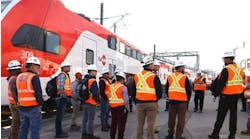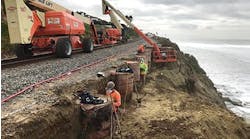The completion of Johannesburg's Bus Rapid Transit (BRT) infrastructure in 2009 saw the first buses of their kind running from Ellis Park to Soweto. This gave the residents of Soweto a welcome choice in how they travel between home and work. BRT provides dedicated lanes for buses, which vastly cuts down the travelling time for commuters. In addition, it provides a regular, predictable timetable.
Although the innovation is welcome, the implementation has been plagued by problems, including political interference during negotiations with stakeholders; threats of strike action by the South African Municipal Workers Union; political pressure to speed up on delivery times; and bad planning practices. These factors affected the ability to deliver the 122km of routes that were promised when the project was approved by the Johannesburg City Council in September 2006. The city delivered only 22km by the end of the 2010-11 fiscal year.
The other problems that have emerged are structural. Many of the completed lanes around Ellis Park and the Soweto Highway are now being rebuilt. Strict time frames as a result of the 2010 Fifa World Cup did not allow for the required re-enforcements to be done and now the lanes have to be rebuilt before they start crumbling under the weight of the buses. The cost might be minimal but it creates the impression of bad planning and wasteful expenditure that will come back to haunt the administration.
In addition, the planning of lanes in the middle of the road on a one-way road had a further negative effect on the flow of traffic in the Johannesburg central business district (CBD), causing many accidents that resulted in traffic gridlock in the inner city. A revisiting of traffic-flow patterns in the CBD, especially around the one-way lanes, is required. Further, it is necessary to revisit the legislation that determines road signage in the Southern African Development Community before it can be gazetted. BRT signage has not been provided for in the legislation as this is a new mode of transport.
These problems should have been factored into the original planning of the project. These teething problems, though very costly, will no doubt be passed off as part of a learning phase and not as failure. It can also be argued that the mistakes Johannesburg made has given Cape Town the opportunity to watch, learn and improve, and where Cape Town errs, Johannesburg can learn in the next phase, and so on.
A very important lesson that should have been learnt from the planning and consulting processes in South America must be that a project of this magnitude cannot be rushed. Johannesburg should have taken the time to investigate and test products used, such as rumble strips and lane markings.
Operational problems that need to be addressed include the bad advertising and communication of the Inner City Distribution System (ICDS). The ICDS, which is still running below the expected capacity, can be seen as a critical failing point. These problems have still not been addressed successfully.
The financial modelling of the system also needs to be more competitive with other existing systems, such as Metro Bus. Metro Bus is operating at about R37/km - despite an unrealistic and very high salary bill. The BRT is operating at about R65/km, including the amount payable to the operating company.
The long-term sustainability of a system should be weighted against the travel time to determine the economic viability of the system and only then can we determine whether the BRT is economically viable or just a & nice to have& The real cost of the buses, including the bank charges, loan costs and interest should be factored into the equation.
Will the following phases be better? I believe they can be. However, the future success of the system will be determined by prioritising the routes, which should not be according to a political vote, but the need to cut travelling times and creating a sustainable transport system.
There is a dire need to link the west of the province as far as Mogale City with Ekhurhuleni via the Johannesburg CBD and Sandton. The vision of the BRT should be to create a sustainable system that will most benefit the economy of the province - not what it will bring the city in accolades from countries that don't understand the dynamics of greater Johannesburg. BRT is no longer a city project but one needed for a dynamic global city region such as Gauteng.
& 8226; De Jager is the Democratic Alliance spokesman for transport
Copyright 2008 LexisNexis, a division of Reed Elsevier Inc. All rights reserved.
Terms and Conditions | Privacy Policy


